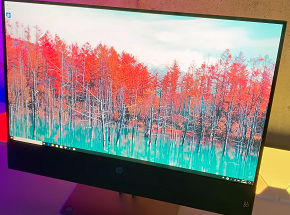The HP Pavilion All-in-One 27 is a sleek and powerful computer that offers a seamless fusion of productivity and entertainment. With its large 27-inch display, powerful components, and all-in-one design, it is a popular choice for both home and office environments. However, one of the significant limitations of this machine is its inability to upgrade the graphics card. This article will explore the reasons behind this limitation and discuss the possible implications for users.
The graphics card, also known as the GPU (Graphics Processing Unit), is a critical component in any computer system, especially for users who engage in gaming, video editing, or other graphics-intensive tasks. It is responsible for rendering images, videos, and animations on the screen, and its performance directly affects the visual experience.
The inability to upgrade the graphics card in the HP Pavilion All-in-One 27 stems from its unique design. Unlike traditional desktop computers, the All-in-One 27 combines the display and the computer components into a single unit. This compact and space-saving design offers several advantages, such as reduced clutter and easy setup. However, it also presents limitations when it comes to upgrading individual components.
Inside the All-in-One 27, the components, including the graphics card, are tightly integrated into the system. This integration results in a lack of modular design that would otherwise allow users to replace or upgrade individual parts at their discretion. Instead, the graphics processing capabilities are directly integrated into the motherboard, making it nearly impossible to remove or swap out the GPU.
While this limitation may disappoint some users, it is essential to understand the intended market for the HP Pavilion All-in-One 27. This computer is primarily designed for everyday computing tasks, multimedia consumption, and light to moderate gaming. It excels in these areas with its vibrant display, powerful processors, and ample memory.
The absence of upgradable graphics cards does not necessarily mean that users will be stuck with outdated or inadequate performance over time. The HP Pavilion All-in-One 27 comes with pre-installed graphics card options that offer competent performance for most users' needs. HP ensures that the initial configuration meets the expected requirements for the computer's intended usage.
However, it is crucial to consider that technology is rapidly advancing, and software demands are constantly growing. What may be considered sufficient for today's applications might not meet tomorrow's requirements. Users with long-term plans or ambitions to explore more demanding applications should carefully consider whether the HP Pavilion All-in-One 27 will meet their needs.
The inability to upgrade the graphics card also raises concerns for gamers or professionals in industries that rely heavily on graphics performance. For these users, having the ability to upgrade to a more powerful GPU is often a necessity rather than a luxury. They require the latest hardware to ensure smooth gameplay or seamless rendering of complex models or animations.
In such cases, users would be better off opting for a traditional desktop PC that allows easy component upgrades. These machines typically come with a separate and removable graphics card, providing the necessary flexibility for future improvements. It is worth noting, however, that traditional desktops are generally more cumbersome and take up more space than an All-in-One system.
The lack of upgradable graphics cards in the HP Pavilion All-in-One 27 may also be a strategic decision by HP. By restricting upgrades, they maintain control over the system's stability and ensure that user experiences are consistent across the entire product line. Upgrades, especially when performed by inexperienced users, can introduce compatibility issues or even reduce overall system performance.
Furthermore, the integration of the graphics card into the motherboard enables HP to streamline the manufacturing process, reduce costs, and offer the All-in-One 27 at a competitive price point. This approach makes the system more accessible to a broader audience, as it eliminates the additional expense associated with high-end graphics cards.
In conclusion, the HP Pavilion All-in-One 27 is an impressive computer that offers a range of features tailored to everyday computing tasks and multimedia consumption. However, the inability to upgrade its graphics card can be seen as a significant limitation for users with specific requirements, such as gaming or graphics-intensive professional applications. While the system is perfectly capable for most users, those with more demanding needs should consider alternative options that provide flexibility for future GPU upgrades.




